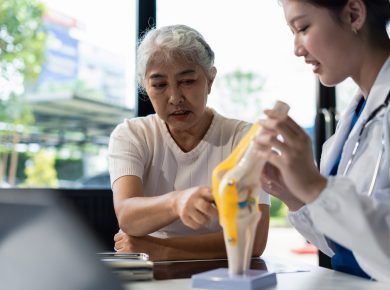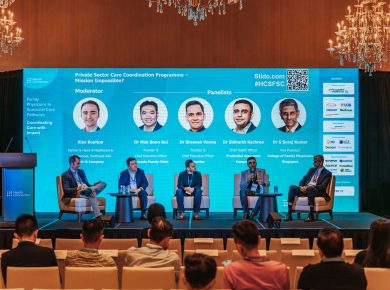Dr Reyaz Singaporewalla, Senior Consultant Surgeon at ACE Specialist Surgery and Endoscopy (a member of Beyond Medical Group), has over 25 years of experience in general surgery. He shares his expert opinion on cholecystectomy, also known as gallbladder removal surgery.
The Role of the Gallbladder and Why a Cholecystectomy May Be Needed
The gallbladder is a small organ located beneath the liver. Its primary function is to store bile, a digestive fluid produced by the liver that helps break down fats during digestion. When you eat, the gallbladder contracts, releasing bile into the small intestine to aid in digestion.
However, issues like gallstones, gallbladder inflammation or biliary dyskinesia (improper contraction of the gallbladder) can cause significant discomfort and lead to complications. These conditions may result in severe abdominal pain, infection, or even pancreatitis if the bile ducts are obstructed. In these cases, a cholecystectomy is often recommended to prevent serious complications.
Rest assured, the gallbladder is a non-essential organ, so most patients can live a normal life without it. With the gallbladder gone, the bile will not be stored in the gallbladder anymore; it will flow directly from the liver into the intestines instead. Although this new bile flow may lead to short-term digestive issues, they can typically be resolved with some dietary modifications.
Cholecystectomy: Procedure, Benefits, and Risks

There are two main types of cholecystectomy:
- Laparoscopic (keyhole) Cholecystectomy: The minimally invasive surgery is performed by making tiny incisions in your abdomen. Through one of those incisions, a laparoscope, a thin tube with a camera and light source, is inserted in the abdomen to facilitate gallbladder removal.
- Open Cholecystectomy: The invasive surgery is performed by making a 15-centimetre incision in the abdomen. The surgeon then retracts the surrounding muscle and tissue to expose the gallbladder for removal.
As laparoscopic cholecystectomy is less invasive than open cholecystectomy, it typically offers faster recovery times and less postoperative discomfort, making it the preferred option for most patients. Nonetheless, general surgeons might occasionally switch from laparoscopic cholecystectomy to open cholecystectomy for safety reasons under certain situations, for instance, extensive bleeding, extensive inflammation or difficult anatomy.
While the surgery is generally safe, there are risks associated with it. It is important to carefully discuss the benefits and risks of undergoing cholecystectomy with your general surgeon before opting for it:
| Benefits | Risks |
|---|---|
| Improved Quality of Life: Most patients experienced relief from symptoms such as gallstone pain, bloating, nausea, vomiting, and digestive issues caused by gallbladder inflammation. | Common Side Effects: Nausea, diarrhoea, and mild abdominal pain, which typically resolve independently. |
| Prevention of Further Episodes of Gallstone Blockages: There is usually a low recurrence of gallstones. | Rare Side Effects:
|
| Prevention of Complications: Complications like gallbladder infections or pancreatitis are less likely to occur. |
Post-Surgical Care for Cholecystectomy
After cholecystectomy, patients will be closely monitored by their surgical team in the recovery room for approximately 2 to 6 hours, depending on individual recovery progress and whether the procedure was laparoscopic or open. Vital signs are tracked, and pain is managed with appropriate medications. The monitoring ensures there are no immediate complications such as bleeding, bile leakage, or adverse reactions to anesthesia.
Dietary Recommendations

Patients usually need to make significant changes to their diet after a cholecystectomy, particularly in the initial months post-surgery. Here are some general guidelines on the key dietary adjustments:
- Smaller, More Frequent Meals: Avoiding large meals can help ease digestion and alleviate gastrointestinal discomfort.
- Low-Fat Meals: Start with a low-fat diet since the absence of the gallbladder can make it harder to digest fats.
- Fibre-Rich Meals: It is advisable to slowly introduce fibre after surgery, as consuming too much fibre too quickly might lead to bloating or gas. Over time, incorporating fibre into the diet can help maintain digestive balance.
It is important to understand that the recommendations above are only a guideline. You should consult your general surgeon for personalised guidance. Many individuals will eventually return to a regular diet, though fatty foods may still cause bloating or diarrhea for some.
Recovery Timelines
The recovery timeline varies depending on whether the patient undergoes laparoscopic or open surgery. Most patients who undergo laparoscopic cholecystectomy can return to regular activities within a few weeks, whereas those with open cholecystectomy usually require more time for full recovery. During this period, patients should gradually resume activities, avoiding heavy lifting or strenuous exercise initially.
Follow-Up Care
After a cholecystectomy (gallbladder removal), follow-up visits with a general surgeon typically occur:
- Within One to Two Weeks Post-Surgery: This initial visit allows the surgeon to assess wound healing, monitor any post-surgical symptoms, and check for complications.
- Long-Term Follow-Up: For many patients, no further follow-ups are needed unless complications arise. However, some patients, especially those with pre-existing symptoms like dyspepsia, may require an additional check around 6 weeks post-surgery to monitor outcomes.
It’s important to remain vigilant for signs of post-cholecystectomy complications, such as persistent pain or significant changes in bowel movements, as these may require further medical evaluation.
Long-Term Outlook
The majority of patients can live normal lives without a gallbladder, eventually returning to their pre-surgery routines. With some temporary adjustments, most people return to normal eating and exercise habits after recovery from a cholecystectomy.
Visit ACE Specialist Surgery and Endoscopy

For tailored advice on cholecystectomy, please book an appointment with ACE Specialist Surgery and Endoscopy, which is well-located in Singapore’s Mt Elizabeth Hospital (Orchard) and Gleneagles Hospital. ACE’s experienced general surgeon, Dr Reyaz, has received extensive training in minimally invasive techniques, including laparoscopic procedures. As a veteran surgeon, Dr. Reyaz has successfully treated many patients with gallbladder inflammation and is particularly skilled in performing laparoscopic cholecystectomy.
About Dr Reyaz Singaporewalla

Dr Reyaz is ACE’s Medical Director and Senior Consultant Surgeon. Prior to setting up his own private clinic, he set up Khoo Teck Puat Hospital’s (KTPH) Endocrine-Head Neck Surgical Service in 2011 and then became the Deputy Head of the Department of Surgery from 2019 to 2020.
Images: ACE, Envato (header) and Shutterstock










